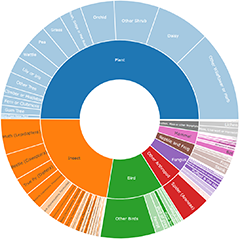Australian Capital Territory
Canberra & Southern Tablelands
New South Wales
Canberra & Southern Tablelands
A guide to Australian insect families (from CSIRO) can be found at:
http://anic.ento.csiro.au/insectfamilies/
Daley, A. & Ellingsen, K., 2012. Insects of Tasmania: An online field guide
A useful introduction to Insects, visit:
http://australianmuseum.net.au/uploads/documents/9362/invertebrate_guide.pdf
A diagram of Insect morphology illustrating terminology with legend of body parts:
https://en.wikipedia.org/wiki/Insect_morphology#/media/File:Insect_anatomy_diagram.svg
A diagram of an insect illustrating terminology based on a worker ant, see:
https://en.wikipedia.org/wiki/Gaster_(insect_anatomy)#/media/File:Scheme_ant_worker_anatomy-en.svg
Photographing insects
There are two main ways to photograph insects with a camera: using a macro close-up lens or a zoom lens. If the insect tolerates your getting very close, then you can use the macro lens. For example, some moths will remain quite still when approached, believing they are camouflaged and invisible. However, many insects, especially those that can fly, will move away when you approach. This is especially true for insects like butterflies and dragonflies. So a good zoom lens is very useful for photographing many insects. If you are using a smartphone, then use a macro lens or a macro attachment. E.g. OlloClip for iPhone. If you want to have an insect identified to species then clear photographs are usually needed because minute parts of the anatomy may need to be checked. It is valuable to take several photos from various angles so that these anatomical details can be seen. Many insects are have particular plants that they feed on, and they can be identified more easily when the associated plant is known. So if the insect is resting or feeding on a plant, take note of what the plant is or ensure that a photo shows the plant clearly.
We're pleased to let you know that NatureMapr Data Collector 6.3.0 has just gone live for both Android and iOS.This important update for the mobile app includes:Ability to re-order images!Numerous bug...
Platform consolidation and impact to regional functionality
NatureMapr 2025 partner update presented to Commonwealth DCCEEW
New feature: special fields for collections
Pterygophorinae (subfamily) at Belconnen, ACT
Perginae sp. (subfamily) at Lyons, ACT
Pterygophorinae (subfamily) at Flynn, ACT
Perginae sp. (subfamily) at Russell, ACT
Perginae sp. (subfamily) at Paddys River, ACT
Perginae sp. (subfamily) at Watson, ACT
Perginae sp. (subfamily) at Cotter River, ACT
